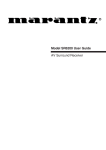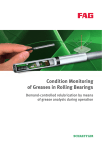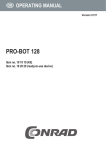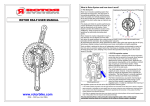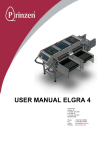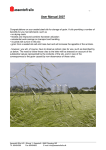Download three phase and single phase asynchronous electric
Transcript
MORATTO S.R.L. Electrical Machinery I – 31030 PERO DI BREDA (Treviso) Italy Via A Volta, 2 Tel. +390422904032 – fax +39042290363 www. moratto.it - [email protected] THREE PHASE AND SINGLE PHASE ASYNCHRONOUS ELECTRIC MOTORS OPERATION AND MAINTENANCE BOOKLET Rev. 2012-01 WARNINGS This operation and maintenance booklet contains important information on safety measures and special instructions about transport, installation, use and maintenance of three and single phase electric motors branded ELMOR. Read these Operating Instructions before you transport, install, commission, maintain or repair industrial motors. These symbols will draw your attention to the safety measures and additional instructions given in these Operating Instructions = Special instructions regarding safety and warranty Danger For reasons of protection of persons and objects, all the safety measures and additional instructions given in these Operating Instructions must be strictly complied with. CAUTION: DO NOT OPERATE THE MOTOR IF IT HAS UNDERGONE DAMAGES IN TRANSIT OR IF IT HAS UNDERGONE VISIBLE DAMAGES. CONTACT THE DEALER OR THE MANUFACTURER FOR ANY CLARIFICATION. Low-voltage machines have dangerous rotating and conductive parts, as well as possibly hot surfaces. All transport, installation, commissioning, maintenance and repair works have to be carried out exclusively by qualified personnel and checked by responsible experts (observe 73/23/CEE, IEC EN 60204, IEC EN 60335) Inappropriate use may cause major damage to persons and objects Should additional data be required, you should immediately consult the manufacturer or an authorized service workshop. All work on electrical connections to the motors and generators should only be carried out by qualified personnel. General information Scope These instructions refer to surface-ventilated three-phase and AC low-voltage cage induction motors and generators, IP 54 and IP 55 to EN 60034 and IEC 34-5. Higher degrees of protection are indicated on the rating plate. These low-voltage machines are intended for industrial installations. They comply with the harmonized standards EN 60034. Observe any possible special prescriptions for their use. Air-cooled low-voltage machines are designed for operation at altitudes ≤ 1000 m above sea level and at ambient temperatures between - 20° C and +40° C. Exceptions are stated on the rating plate. Observe especially different indications on the rating plate. The conditions at the place of use must coincide with all the data of the rating plate. The low-voltage machines are components of a machine according to the Directive Machines 2006/42/CE. The commissioning of this machine is forbidden until conformity of the final product with this directive is proved (observe EN 60204-1). ENGLISH 1 2012-01 Transport Should any damage be observed after delivery of the low voltage machine at its destination, these should be notified immediately to the transport company; avoid commissioning. Lifting eyes Lift motors only on lifting eyes provided. Do not add any load to the motor. Lifting eyes are designed for the motor mass only. Should it be necessary, use appropriate cable guides. Ventilation The distance between air intake of the motor and walls or other machinery must be at least ¼ of the diameter of the air intake opening. Cooling air flows from the non-drive end towards the drive end. Air leaving the motor must not be drawn in again by the fan. Keep air inlets and outlets clean. For vertical shaft-up designs, suitable protection must be provided at the mounting end so that no foreign matter can enter the ventilation hole. Such protection must, however, not affect the cooling and air leaving the motor/generator - or adjacent groups - must not be drawn in again. Condensation drain holes Even after installation the condensation drain holes must be at the lowest point of the motor. They must be kept clean. Plug drain hole after each drainage. Installation and commissioning Mechanical – Transmission elements Use elastic couplings only; rigid couplings require a special bearing design. When using transmission elements which provoke radial or axial shaft loads during operation (e.g. pulleys, gearwheels, etc.) take care that the permissible loads are not exceeded. Relevant data are given in the respective technical catalogue. In no way the ball bearings should suffer pressure or strokes, in transit, installation and during motor operation. Mechanical - Substructure Make sure that the feet or flanges are safely fixed and rest positively on their entire surface. Check also the exact alignment with direct coupling. All motor feet must rest positively on their entire surface to avoid distortion of the motor frame. Mechanical - Alignment When the motor is connected to the driven machine via a coupling, the shafts must be aligned radially and axially to each other. The correct alignment of the transmission must be verified after a reasonable period of operation of the machine, when the motor is warm. Do not disable the safety devices even during testing. If in doubt, turn the motor off. Electrical – Voltage and winding connection The admissible fluctuation between rated voltage and supply voltage is ± 5%; for rated frequency, ±2% is allowed. Observe different connection indications and data on the rating plate, as well as the connection diagram in the terminal box. Electrical - Connection Choose cable cross-sections in accordance with the rated current. Not used cable entries must be closed by compression glands. (Norma IEC EN 60204-1) Work should only be carried out by qualified personnel, always with the machine out of operation, disconnected and previously secured against starting. This is also valid for auxiliary circuits (e.g. heaters).Make sure that there is no voltage! The supply cables must be connected with special care to ensure permanent and reliable contact (without loose cable ends); use suitable terminals for the connection cables. Supply cables must be stress-relieved so that no cantilever loads are exerted on the terminals. ENGLISH 2 2012-01 Ensure a good connection of the protective conductor. The minimum safety distances between conductors and between those and earth should not exceed the following values: ≤ 550 V 8mm; ≤750 V 10mm; ≤ 1000 V 14mm. Make sure that no foreign matter is left in the terminal box, and that it is clean and dry. Cable entries which are not used and the terminal box itself have to be sealed dust and water-tight. In order to maintain the degree of protection, always make sure that the original gaskets are used when closing the terminal box. Connect protective conductor here. If the power supply cable is damaged, it must be replaced by the manufacturer or its service agent or a similarly qualified person in order to prevent the risk. Electrical - Starting Before running the test of the motor without transmission elements, lock the key/keys against the screening and check that the motor is securely fixed. Before the start up of the brake motors, make sure that the brake is working properly. Electrical - Direction of rotation Normally, the motors are suitable for both directions of rotation. Exceptions are indicated on the rating plate by an arrow. For the desired direction of rotation, the stator winding is connected as follows: L1,L2,L3 connection Direction of rotation from the control side U1, V1, W1 Clockwise W1, V1, U1 Counterclockwise Electrical – Reversing the direction of rotation The direction of rotation of the motor can be reversed as shown in the following table. Verify the absence of power supply, before proceeding to the change the direction of rotation. Mode of starting and winding Direct-on-line starting and pole-changing motors with separate windings Star/delta starting and pole-changing motors with Dahlander winding Measures Exchange two supply-cable conductors on the terminal board of the motor Exchange two supply-cable conductors at the incoming supply to the contactor combination Electrical - Test To check the direction of rotation, switch the properly connected but uncoupled motor quickly ON/OFF. Electrical - Y/∆ Starting In order to avoid excessive transient currents and torques, before changing over from Y to Δ, wait until the starting current of the Y stage has died down or run-up has concluded (e.g. change over when rated speed is reached). Electrical – Motor protection Unless specifically requested during the purchase, motors have no protection against overcurrent, overtemperature and overspeed. These are mandatory and charged to the user, unless otherwise agreed. (IEC EN 60204-1) Connect semiconductor temperature detectors to the release device in accordance with the wiring diagram. Continuity test, if necessary, to be carried out by means of a measuring bridge only (max. 2.5 V). In order to achieve full thermal protection, an additional thermally delayed overload protection must be installed (Fig. 7). Normally, fuses alone protect only the supply system not the motor. Maintenance Before carrying out any work on the motor, disconnect it and secure it against restarting. Caution, danger of accidents: Take care not to come in contact with moving parts! ENGLISH 3 2012-01 Cleaning Depending on the local conditions, air passages should be cleaned regularly. Maintenance of bearings Motors made by Moratto S.r.l. have ball bearings with permanent lubrication. Under normal operating conditions, motors can be operated for about 20,000 hours without maintenance. However, the maximum period of maintenancefree operation is four years. If necessary, replace the bearings. Fill the spaces between the balls and the roller tracks as well as the grease compartments half with grease. Coat shaft bushings in the bearing caps or end shields with a thin layer of grease. Permanently greased bearings (2RS and 2Z bearings) cannot be washed and regreased. Such bearings must therefore be replaced. To dismantle the bearings, use pressing screws or other appropriate devices. Repair instructions Any repair work within the guarantee period is subject to the approval of the motor manufacturer. General It is strongly recommended that only original spares be used for motor repairs. Instructions for storage of motors Place For prolonged storage of electric motors (e.g. spare motors), the following precautions must be observed: Make sure that they are kept in a dry and dust free place with minimum vibration (Speed eff. ≤ 0.2 mm/s) (damage to stalled bearings). Ambient temperature + 10° C to + 40° C, relative humidity < 50 %. Where pulleys, half couplings, etc. are already mounted on the shaft extension, fit the locking device or place the motor on vibration dampers, if possible. Use dampers and locking device also for any future transport of the motor. Check before commissioning Bearings Before commissioning a motor that has been stored for more than 4 years, check the bearings. For motors without regreasing device, grease has to be renewed or bearings have to be changed after 2 years at the latest. Insulation resistance Before commissioning check the insulation resistance. With values ≤ 1kW per Volt rated voltage, dry the winding. Check the insulation resistance of each phase against earth by means of a hand-driven generator (max. 630 V DC) until the measured value is constant. The insulation resistance of new windings is above 10 MΩ. The resistance can be lowered considerably by moisture. If, at room temperature, the resistance is below 0.5 MW, the winding must be dried. In this case the winding temperature must not exceed 80° C. For drying connect the space heater or another heating device, or apply an AC voltage of 5 or 6 % (connect in delta) of the rated motor voltage to terminals U1 and V1. Repeat the measurement. The motor can be put into operation when the resistance is above 0.5 MΩ. Insulation resistance is temperature-dependent, i.e. if the temperature is increased/decreased by 10 K, the resistance value is halved/doubled, respectively. Wiring diagrams THREE PHASE, SINGLE SPEED A B W2 U2 V2 W2 U2 V2 U1 V1 W1 U1 V1 W1 R S T R S SINGLE PHASE Double voltage motors (es: V 230/400) W2 Wiring A = 400V Wiring B =230V U2 U1 V2 V1 W2 W1 U2 U1 V2 V1 W1 T L L L L Visit www.moratto.it for more information. ENGLISH 4 2012-01 Troubleshooting Three phase motor PROBLEM REASON SOLUTION The motor does not start, you cannot At least two phases are hear the typical starting noise discontinued, lack of voltage The motor does not start, you hear a One phase is discontinued loud buzzing Friction between rotor and stator The motor does not start under load, Too high resistant torque but the magnetic hiss is regular Too low voltage The motor does not reach the One phase is discontinued after correct speed starting Loss of speed, buzz The ammeter in the stator circuit reports periodic variations The motor warms up already during Wiring error, for instance Y the idle running connection instead of delta connection. Too high voltage Insufficient cooling due to the ventilation channels clogged The motor gets too hot under load Too high load Too low or too high voltage One phase is discontinued Friction between rotor and stator The motor makes abnormal noise Mechanical or electrical factors The pole-changing motor rotates with a wrong number of revolutions The pole-changing motor rotates with a single speed only Wiring error One or more lines or connections between terminals and polechanger are defective or broken Check all protective elements power lines and terminals Locate the interrupted phase, check the fuses, replace the damaged ones. Check the ball bearings, check the coupling and the correct tension in the belts Check the machine coupled to the motor, uncouple the motor and see if it work properly at no load Measure line voltage Check the supply line Possible rotor fault, see a specialist Check and fix the connections according to the diagram Measure line voltage and no load current Clean the ventilation channels Measure current Measure both voltage and current Check line voltage Find the discontinued phase Check the coupling and the correct tension in the belts If defects concern the electrical part, the noises disappear when disconnecting the motor; in case of defects on the mechanical part, noises often decrease with the reduction of speed. Contact the manufacturer Check and fix the connections according to the diagram Check the connections between terminals and line Single speed motor PROBLEM REASON The motor does not start, you cannot Interruption of the line, lack of hear the typical starting noise voltage The motor does not start under load, Too high resistant torque but the magnetic hiss is regular The ammeter in the stator circuit reports periodic variations The motor warms up already during Insufficient cooling due to the the idle running ventilation channels clogged The motor gets too hot under load Too high load Too low or too high voltage Friction between rotor and stator The motor makes abnormal noise Mechanical or electrical factors ENGLISH 5 SOLUTION Check all protective elements power lines and terminals Check the machine coupled to the motor, uncouple the motor and see if it work properly at no load Possible rotor fault, see a specialist Clean the ventilation channels Check the coupling and the correct tension in the belts Measure the current Contact the manufacturer If defects concern the electrical part, the noises disappear when disconnecting the motor; in case of defects on the mechanical part, noises often decrease with the reduction of speed. Contact the manufacturer 2012-01






